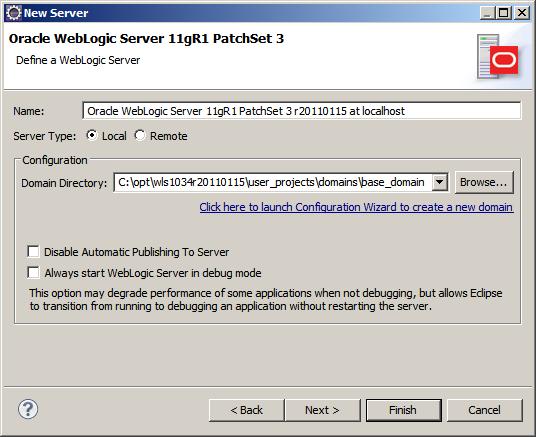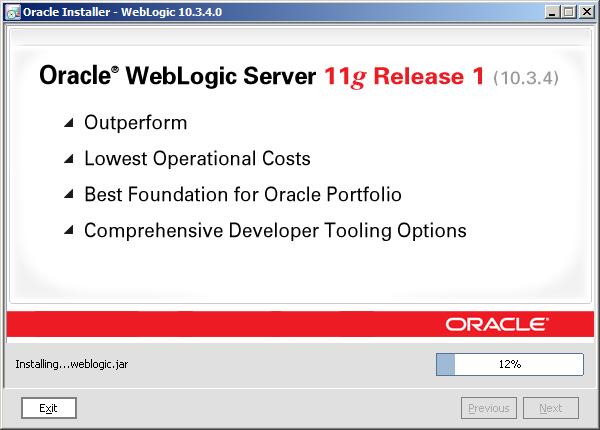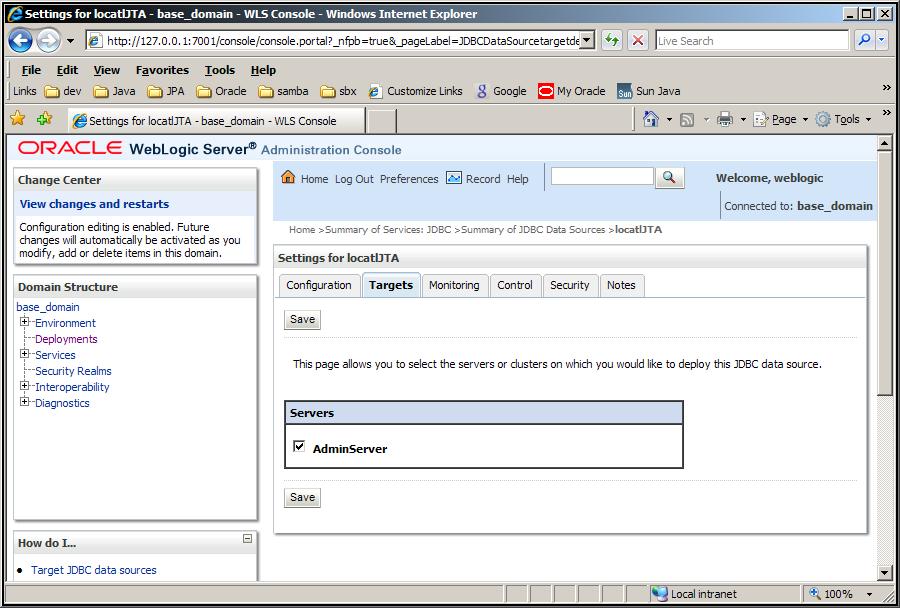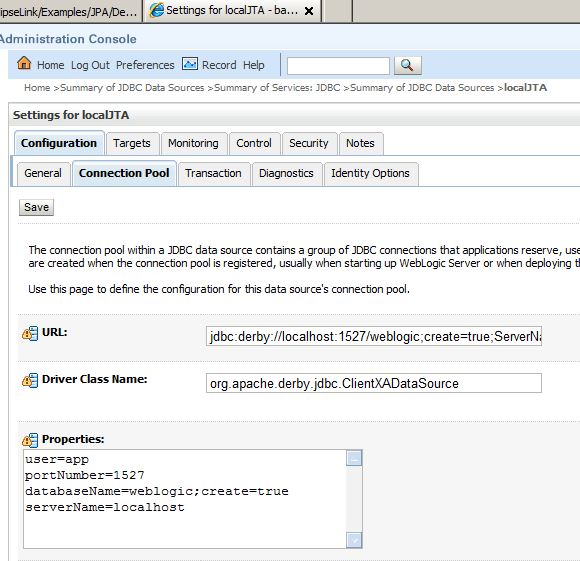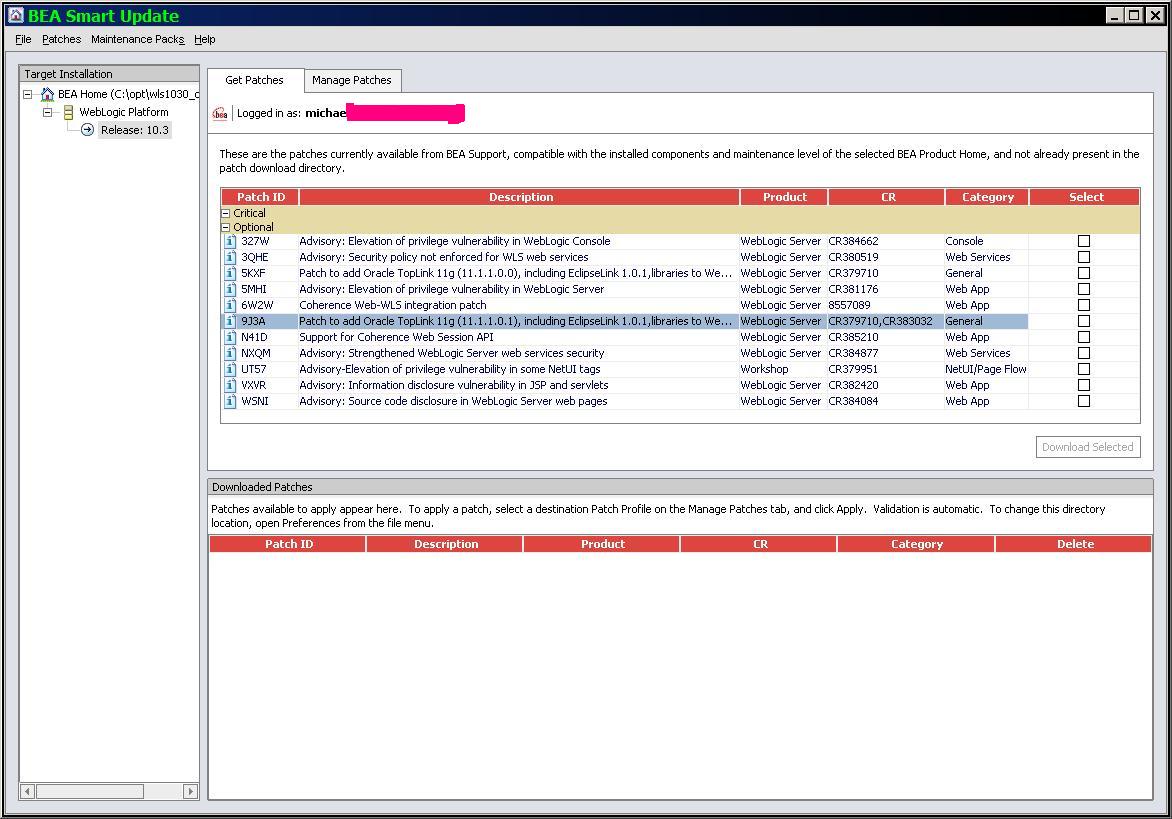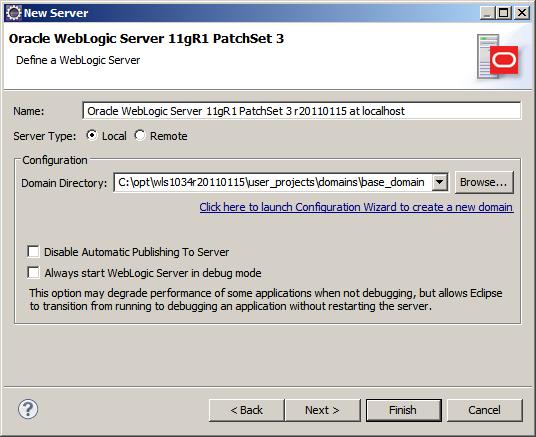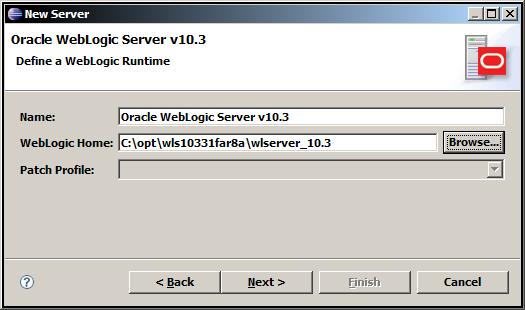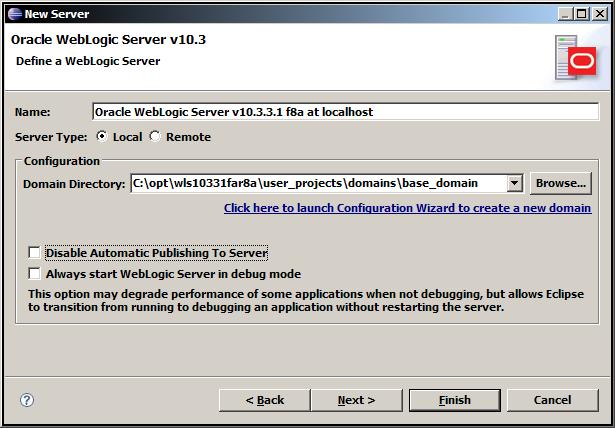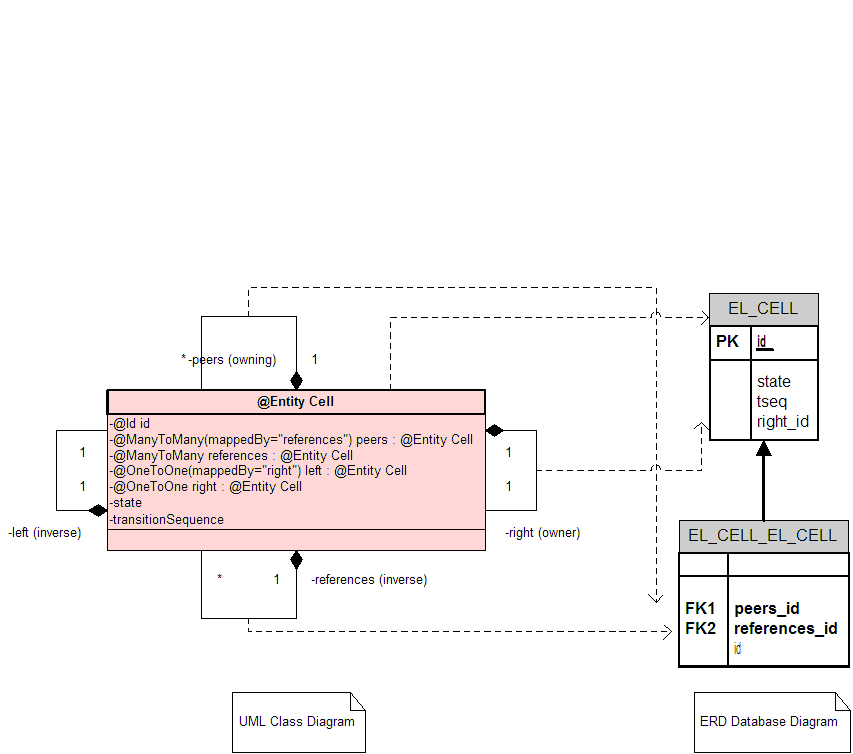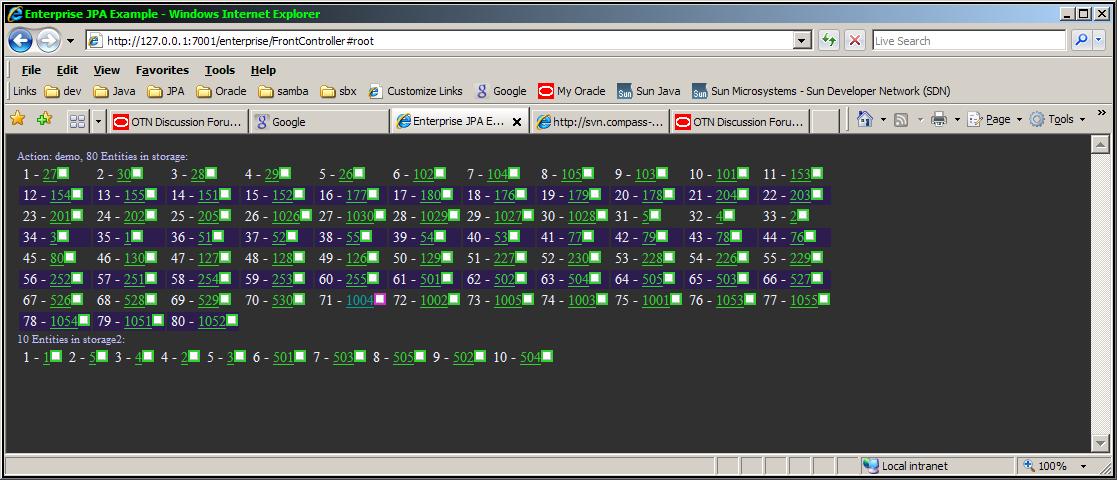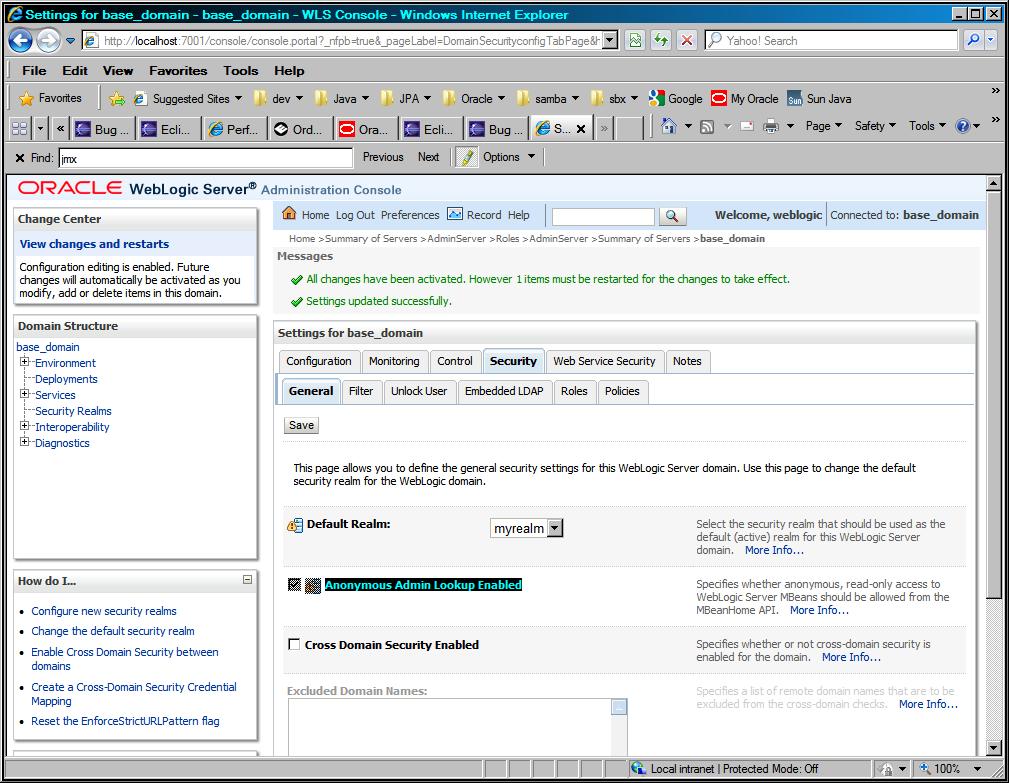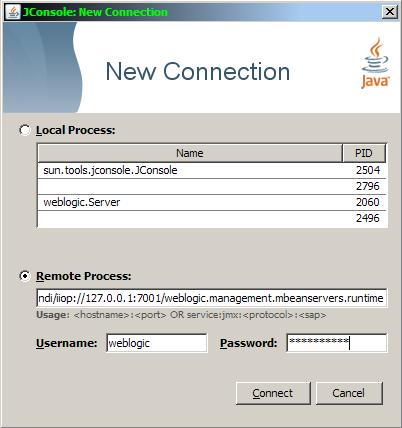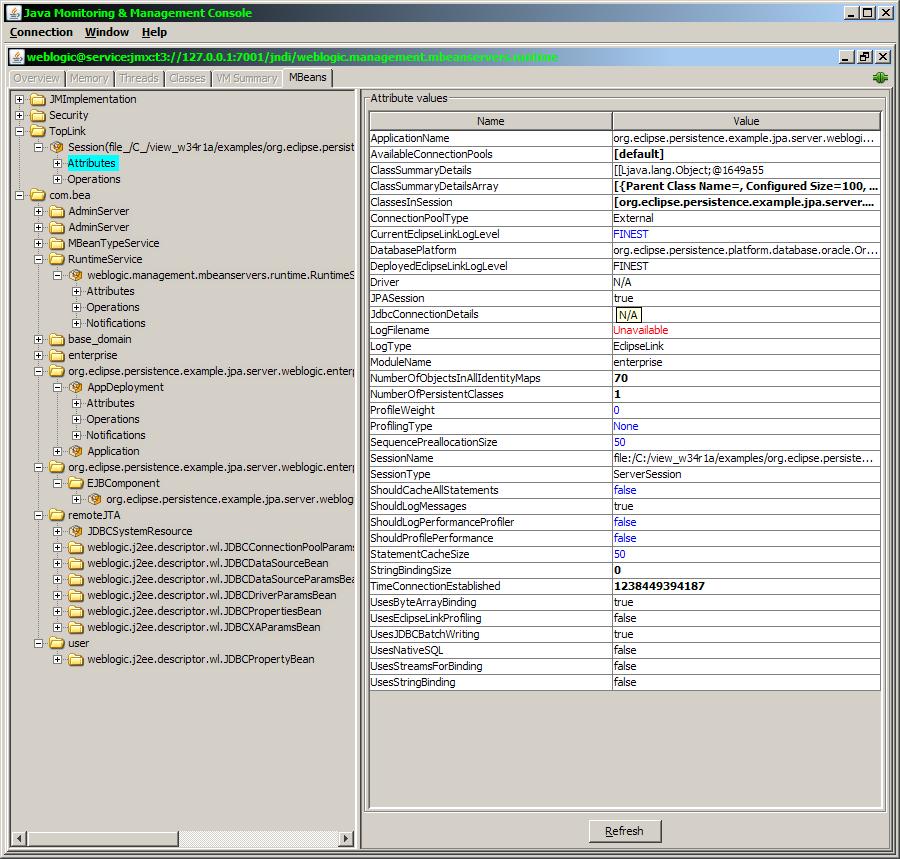Notice: This Wiki is now read only and edits are no longer possible. Please see: https://gitlab.eclipse.org/eclipsefdn/helpdesk/-/wikis/Wiki-shutdown-plan for the plan.
EclipseLink/Examples/JPA/WebLogic Web Tutorial
Contents
- 1 EclipseLink JPA Deployed on Oracle WebLogic using Eclipse WTP
- 1.1 Oracle Cloud using WebLogic 12.1.1.0 and JPA 2.0
- 1.2 Alternate Distributed JPA Application using a WebLogic Central Server
- 1.3 Tutorial Source
- 1.4 Development Environment
- 1.5 Prerequisites
- 1.5.1 Install Eclipse EE
- 1.5.2 Install a Database
- 1.5.3 Install Oracle WebLogic Server
- 1.5.4 Install Oracle WebLogic Server Tools for Eclipse
- 1.6 WebLogic configuration Changes
- 1.7 JNDI Datasource Setup
- 1.8 EclipseLink JAR location
- 1.8.1 Upgrade EclipseLink Module on WebLogic - org.eclipse.persistence_1.0.0.0_major_minor.jar
- 1.8.2 Other ways to upgrade EclipseLink on WebLogic
- 1.8.3 javax.persistence.jar
- 1.8.4 eclipselink.jar on the Server or EAR?
- 1.8.5 Option 1: Leave EclipseLink shipped on modules directory - Recommended for 10.3.2.0
- 1.8.6 Option 2: Apply Smart Update Patch - Recommended for 10.3.0.0
- 1.8.7 Option 3: eclipselink.jar on domain
- 1.8.8 Option 4: eclipselink.jar specified at startup
- 1.8.9 Option 5: eclipselink.jar on server - not recommended
- 1.8.10 Option 6: Override and Download EclipseLink Libraries from Eclipse.org
- 1.9 JSR-317 JPA 2.0 Support
- 1.10 JDBC JAR location
- 1.11 Create server in Eclipse
- 1.12 Create J2EE application
- 1.13 Persistence.xml
- 1.14 Start Server
- 1.15 Publish EAR
- 1.16 Perform a JPQL query using a Stateless EJB Session Bean injected on a Servlet Controller
- 1.17 Alternate JNDI lookup of Injected EntityManager on a Stateless Session Bean
- 1.18 Console Output
- 1.19 Browser Output
- 1.20 Deploying a Secure Enterprise Application on WebLogic
- 1.21 Troubleshooting
- 1.22 EJB bean JNDI client lookup without injection
- 1.23 JMX MBeans
- 1.24 References
- 1.25 Bugs
- 1.26 Oracle WebLogic Server Documentation Links
EclipseLink JPA Deployed on Oracle WebLogic using Eclipse WTP
Oracle Cloud using WebLogic 12.1.1.0 and JPA 2.0
- Database access from Oracle Java Cloud Service application
- Related Annotations
- EJB 3.1 Timer @Singleton does not start on Oracle Cloud - works locally
Alternate Distributed JPA Application using a WebLogic Central Server
- See the Distributed JPA Application case study on how JPA works and deals with Optimistic lock exception scenarios using Java EE 6 API elements - specifically as a single persistence unit used by the distributed application as an alternative to using a shared L2 cache. This tutorial also demostrates use of alternate client and presentation frameworks that include any number of concurrent distributed Java SE clients that get, process and submit work units to the central server via a remote stateless session bean instance.
If you want to get a small JPA / EJB 3 based web application running quickly on WebLogic - the services provided by the Web Tools Project plugin in the Eclipse IDE can take care of the deployment details and set the server into debug mode for you.
This basic example details how to use Eclipse to run/debug a minimum J2EE web application servlet using EclipseLink JPA as the persistence provider. The goal of this example is to detail the minimum steps needed to run EclipseLink inside WebLogic using the Eclipse IDE - at this point no presentation/controller layer such as JSF, Spring or Struts will be used beyond a basic HttpServlet so we can concentrate on the the integration layer JPA setup.
Tutorial Source
The EAR, EJB and WEB Eclipse project source for this EclipseLink WebLogic tutorial is available online at the following locations. These 3 projects must be imported along with the jpa core eclipselink project.
- Checkout the following 4 projects together from $trunk/examples.
- org.eclipse.persistence.example.jpa.server.weblogic.enterpriseEAR
- org.eclipse.persistence.example.jpa.server.weblogic.enterpriseEJB
- org.eclipse.persistence.example.jpa.server.weblogic.enterpriseWeb
- org.eclipse.persistence.example.jpa.server.entities
- EclipseLink source via SVN committer access
svn+ssh://user@eclipse/svnroot/rt/org.eclipse.persistence/trunk
- EclipseLink source via SVN anonymous access
svn://dev.eclipse.org/svnroot/rt/org.eclipse.persistence/trunk
The following link will put you at the root of the SVN tree using the online version of subclipse.
And the DDL generation J2SE JPA application used to populate the database schema.
Development Environment
Hardware: Windows 7 64-bit, Dell XPS436 Corei7 920 , 2.7Ghz, 12Gb Ram, Raptor HD
Software: Eclipse IDE for Java EE 3.5 SR-2 Galileo (Sept 2009), Derby 10.5.3.0, SUN Java JDK 1.6.0_18, WebLogic 10.3
This example will run fine with Eclipse 3.4 EE and any Database that EclipseLink supports.
Prerequisites
Install Eclipse EE
- I use to install a clean version of Eclipse Galileo 3.6 EE edition and add the OEPE - Oracle Enterprise Pack for Eclipse plugin for WebLogic.
- However, currently I get everything to run out of the box by installing Oracle WebLogic Server 11gR1 10.3.3.0 with integrated Coherence and Oracle Enterprise Pack for Eclipse 11.1.1.5 (OEPE) .
- I modified the eclipse.ini testing/development file.
Install a Database
- In this example I am using Oracle 11g, the table schemas have already been created manually and all entity java classes have been generated using the Eclipse DALI tool.
Install postgreSQL in WebLogic 12.1.2
- 20140319: Tutorial assumes EclipseLink 2.4.2.v20130514-5956486 running on WebLogic 12.1.2.1 on OSX 10.9 using postgreSQL 9.3
- the postgreSQL JDBC driver jar does not come with WebLogic
- modify the class
- Download the latest postgreSQL 9.3 JDBC 4.1 jar from http://jdbc.postgresql.org/download.html
- postgresql-9.3-1101.jdbc41.jar
- Install postgreSQL 9.3 on the mac
- Create a database by runnng Applications/PostgreSQL 9.3/pgAdmin III
JAVA SE RESOURCE_LOCAL persistence.xml
<persistence-unit name="example" transaction-type="RESOURCE_LOCAL">
<provider>org.eclipse.persistence.jpa.PersistenceProvider</provider>
<properties>
<property name="eclipselink.target-database" value="PostgreSQL"/>
<property name="javax.persistence.jdbc.driver" value="org.postgresql.Driver"/>
<property name="javax.persistence.jdbc.url" value="jdbc:postgresql://localhost:5432/obrienlabs"/>
<property name="javax.persistence.jdbc.user" value="postgres"/>
<property name="javax.persistence.jdbc.password" value="postgres"/>
<!-- DDL generation creates our DB in SE only -->
<property name="eclipselink.ddl-generation" value="drop-and-create-tables"/>
<property name="eclipselink.ddl-generation.output-mode" value="both"/>
- results
[EL Info]: 2014-03-19 18:03:22.718--ServerSession(1898536649)--Thread(Thread[main,5,main])--EclipseLink, version: Eclipse Persistence Services - 2.4.2.v20130514-5956486 [EL Config]: connection: 2014-03-19 18:03:22.722--ServerSession(1898536649)--Connection(223623898)--Thread(Thread[main,5,main])--connecting(DatabaseLogin( platform=>PostgreSQLPlatform user name=> "postgres" datasource URL=> "jdbc:postgresql://localhost:5432/obrienlabs"
JAVA EE JTA Container Managed persistence.xml
<persistence version="2.0" xmlns="http://java.sun.com/xml/ns/persistence" xmlns:xsi="http://www.w3.org/2001/XMLSchema-instance" xsi:schemaLocation="http://java.sun.com/xml/ns/persistence http://java.sun.com/xml/ns/persistence/persistence_2_0.xsd">
<persistence-unit name="gps" transaction-type="JTA">
<properties>
<provider>org.eclipse.persistence.jpa.PersistenceProvider</provider>
<property name="eclipselink.target-database" value="PostgreSQL"/>
<property name="eclipselink.target-server" value="WebLogic"/>
- results
[EL Config]: connection: 2014-03-19 19:50:20.599--ServerSession(1214490893)--Connection(1145000203)--Thread(Thread[[ACTIVE] ExecuteThread: '0' for queue: 'weblogic.kernel.Default (self-tuning)',5,Pooled Threads])--connecting(DatabaseLogin( platform=>PostgreSQLPlatform user name=> "" connector=>JNDIConnector datasource name=>null )) [EL Config]: connection: 2014-03-19 19:50:20.599--ServerSession(1214490893)--Connection(417451054)--Thread(Thread[[ACTIVE] ExecuteThread: '0' for queue: 'weblogic.kernel.Default (self-tuning)',5,Pooled Threads])--Connected: jdbc:postgresql://127.0.0.1:5432/obrienlabs User: postgres Database: PostgreSQL Version: 9.3.3 Driver: PostgreSQL Native Driver Version: PostgreSQL 9.3 JDBC4.1 (build 1101) [EL Finest]: sequencing: 2014-03-19 19:50:20.599--ServerSession(1214490893)--Thread(Thread[[ACTIVE] ExecuteThread: '0' for queue: 'weblogic.kernel.Default (self-tuning)',5,Pooled Threads])--sequencing connected, state is Preallocation_Transaction_NoAccessor_State
Install Oracle WebLogic Server
- Oracle WebLogic Server 11gR1 10.3.3.0 with integrated Oracle Coherence and Oracle Enterprise Pack for Eclipse 11.1.1.5 (OEPE) on OTN Oracle WebLogic Server 10.3 or WebLogic Server
- WEBLOGIC_HOME=C:/bea/wlserver_10.3
- Either apply the appropriate patch using Smart Update or download your own EclipseLink libraries.
Install Oracle WebLogic Server Tools for Eclipse
- You can unzip the plugins zip and copy it over your eclipse install. After you will see the new WebLogic server plugins when creating a new server.
- See outstanding 288275 if you are installing on an older Eclipse Ganymede 3.4 IDE.
Oracle WebLogic Server 12.1.2
- http://docs.oracle.com/middleware/1212/wls/NOTES/index.html#BGGGHCJD
- If you are using the -silent install for WebLogic Server 12.1.2.0 on headless linux/mac server - you need to workaround a bug with the -force option by using the -novalidation option for now.
Java 1.7 enabled. - content pending
Oracle WebLogic Server 10.3.6
Not yet Java 7 enabled
Oracle WebLogic Server 10.3.5
- WebLogic 10.3.5 was released on 15 May 2011.
Oracle WebLogic Server 10.3.4
- For Eclipse 3.6 Helios integration with WebLogic 10.3.4 try to use at least version 1.7.0_20110127 of Oracle WebLogic Server Tools
- See bug # 334468 for tracking info.
- The version of EclipseLink shipped with WebLogic 10.3.4.0 is Eclipse Persistence Services - 2.1.2.v20101206-r8635
Java EE 6 API in this Tutorial
- I will be addressing the following Java EE 6 API's
- Java Persistence 2.0 (JSR 317) - with patch
- JAX-RS (RESTful Web Services) 1.1 (JSR 311)
- JSF (Java Server Faces) 2.0 (JSR 314)
- I will not be officially using the following Java EE 6 API's as part of this tutorial
- CDI (Contexts and Dependency Injection) (JSR 299)
- DI (Dependency Injection) for Java (JSR 330)
- JSP 2.2 / Servlet 3.0 which includes @WebServlet
- Bean Validation (JSR 303)
- EJB (Enterprise Java Beans) 3.1 (JSR 318) - see http://forums.oracle.com/forums/thread.jspa?threadID=1006893&tstart=0
- Web Profile
- Including EJB 3.1 Lite
- For example usage of the Java EE 6 API's that are already in WebLogic 10.3.4.0 like
- JSR 314: JavaServer Faces (JSF) 2.0
- JSR 311: JAX-RS: The Java API for RESTful Web Services 1.1
- You may consult the following distributed EE tutorial.
Oracle WebLogic Server 10.3.3.0
- Vote for bug# 310849 if you would like 10.3.3.0 specific configuration info expanded.
- Oracle Enterprise Pack for Eclipse 11gR1 Patch Set 2 comes preconfigured with WebLogic 10.3.3.0 if you selected the combined download.
- EclipseLink is upgraded from 1.2 to 2.0.
- Follow this tutorial on using the OEPE tool.
- However, you must delete and recreate the supplied Eclipse IDE server instance to get past the following error message.
Cannot load DeploymentManager for Runtime[Oracle WebLogic Server 11gR1 PatchSet 2, Oracle WebLogic Server 11gR1 PatchSet 2, C:/opt/wls10330/wlserver_10.3, RuntimeType[com.bea.weblogic1033, Oracle WebLogic Server 11gR1 PatchSet 2]] The server is invalid. Error occurred reading server credential. If the domain was recreated, the server instance in Eclipse must also be recreated.
- The version of EclipseLink shipped with WebLogic 10.3.3.0 is Eclipse Persistence Services - 2.0.2.v20100323-r68726872
Oracle WebLogic Server 10.3.2.0
- Oracle Enterprise Pack for Eclipse 11gR1 Patch Set 1 (11.1.1.5)] is out as of April 2010 http://www.oracle.com/technology/products/enterprise-pack-for-eclipse/index.html?msgid=8667875&eid=4834861987&lid=1
- Download the 32-bit or 64-bit version for Windows 7 running Eclipse 3.5 Galileo.
Oracle WebLogic Server 10.3.1.0
- The 10.3.1 download on OTN includes OEPE tools
- Eclipse 3.3/3.4 EE does not come with the WebLogic server configurations out of the box, however you can add it from eclipse with the following steps, you must do this in order to pick up the 10.x server plugins.
- In Eclipse goto the link "Download additional server adapters"
- Select Oracle WebLogic Server Tools
- For 10.3.3 installs (use the patchset 2 plugin)
- For 10.3.2 installs (use the patchset 1 plugin)
- Note: The bea-wls-tools-2.0.2 plugin works only up to Eclipse 3.4 Ganymede M5 (not the later RC(n) versions) - this plugin site has been deprecated.
WebLogic configuration Changes
BEA WebLogic 10.0 MP1 Specific configuration
If you must use the older version of WebLogic 10.0.1 then everything in this WebLogic tutorial will run in 10.0 as long as you do the following modifications before deploying the EAR.
- remove the 10.3 specific parts of the weblogic-web-app namespace from enterpriseWeb/WebContent/WEB-INF/weblogic.xml
- remove the 10.3 specific parts of the weblogic-application namespace from enterpriseEAR/EarContent/META-INF/weblogic-application.xml
JVM and EclipseLink Logging
- All JVM and EclipseLink logs will be visible on the WebLogic domain console output window. This window will either be the Java process that runs as a CMD window when WebLogic is launched as a separate process or service, or it will be the server log window when running WebLogic from Eclipse.
- If you would like to see the logs in the base_domain log files then you will need to check the following property that is not set by default from the admin console web application.
- Home >Summary of Deployments >base_domain >Summary of Servers >AdminServer >Summary of Servers >AdminServer
- General | Advanced
- check "Redirect stdout logging enabled"
- Home >Summary of Deployments >base_domain >Summary of Servers >AdminServer >Summary of Servers >AdminServer
JNDI Datasource Setup
Global Scoped Datasource Setup
For ease of use, I would recommend that you use a globally defined datasource on your WebLogic server. This way all your applications can share the same datasource. The setup is also much simpler and requires only a single line in your container managed persistence.xml file.
- Note: Your <jta-data-source> element in persistence.xml must match the JNDI Name: on the server admin page Home >Summary of JDBC Data Sources - either prefixed with jdbc/ or not.
- You may update config.xml directly - not recommended, or use the admin console wizard to create your JNDI datasource.
Setting up a Globally Scoped JNDI Datasource on the WebLogic Server Console
- Navigate to http://127.0.0.1:7001/console
- Select JDBC | Data Sources
- Select new and enter all of the URL, username, password, port, JNDI Name, Name that matches your ejbModule/META-INF/persistence.xml parameters.
<jta-data-source>localJTA</jta-data-source> <!-- equal to JNDI Name and optionally Name -->
- Name = localJTA
- JNDI Name = localJTA
- Database Type = Oracle
- Database Driver = (default) Oracle's Driver (Thin XA) for Intance connections; Versions: 9.0.1,9.2.0,10,11
- Next
- Transaction Options = Next
- Database Name = orcl or your database schema name
- Host Name = 127.0.0.1 or your database IP address
- Database User Name = scott or your database user name
- Password = you know it
- Next (twice)
- Make sure to associate this datasource with your server instance in the last step "Targets"
- Note: after using the admin console - you will need to remove the edit.lok file on your domain before you can do a "run on server" from the Eclipse IDE.
- Select Targets = check AdminServer or your own domain server
- Save
- wls10n/user_projects/domains/base_domain/config/config.xml will contain the following new entry where OracleDS-nnnn-jdbc.xml will contain all the DB properties parameters.
<jdbc-system-resource> <name>OracleDS</name> <target>AdminServer</target> <descriptor-file-name>jdbc/OracleDS-0429-jdbc.xml</descriptor-file-name> </jdbc-system-resource>
Testing the DataSource in the Admin Console
You may verify that your datasource and connection pool are working by testing the datasource from the admin console web page.
- Navigate to Home >Summary of JDBC Data Sources >localJTA >Roles >localJTA | Configuration | Connection Pool
- Expand the Advanced tab
- Check Test Connections On Reserve
- Save
- Goto Monitoring | Testing - select your datasource and click Test Data Source
- You should see Test of localJTA on server AdminServer was successful
Derby JTA Datasource Setup
- See details at Derby 10.5.3.0
Application Scoped Datasource Setup
If you require the use of an application scoped/deployed datasource, please refer to the following documentation on how to setup and reference an application scoped datasource on WebLogic 10.3.
When using JPA you will only require 1 of the 5 custom weblogic descriptors - weblogic-application.xml described below.
Your oracle-jdbc.xml will require an Application scope.
<jdbc-data-source-params> <jndi-name>java:app/jdbc/appDS</jndi-name> <scope>Application</scope>
Your persistence.xml will require both <jta-data-source> and the fully qualified "javax.persistence.jtaDataSource" property defined - override behavior is described in bug# 246126.
<persistence version="1.0" xmlns="http://java.sun.com/xml/ns/persistence" xmlns:xsi="http://www.w3.org/2001/XMLSchema-instance" xsi:schemaLocation="http://java.sun.com/xml/ns/persistence http://java.sun.com/xml/ns/persistence/persistence_1_0.xsd"> <persistence-unit name="unified" transaction-type="JTA"> <provider>org.eclipse.persistence.jpa.PersistenceProvider</provider> <jta-data-source>appDS</jta-data-source> <properties> <property name="javax.persistence.jtaDataSource" value="java:app/jdbc/appDS"/>
EclipseLink JAR location
Upgrade EclipseLink Module on WebLogic - org.eclipse.persistence_1.0.0.0_major_minor.jar
- For advanced users: navigate to your 'modules directory and overwrite the existing eclipselink jar
- In my case WebLogic 10.3.3.0 ships with EclipseLink 2.0 - to upgrade to EclipseLink 2.1 - I overwrite the following jar
- C:\opt\wls10330\modules\org.eclipse.persistence_1.0.0.0_2-0.jar
Other ways to upgrade EclipseLink on WebLogic
- There are at least 6 (six) ways to run EclipeLink on WebLogic, the details are below.
- Issues to keep in mind are...
- How high do you want the EclipseLink libraries in the classpath tree (remember that the JPA specification jar must be at or above whereever you decide to run EclipseLink)?
- What version do you wish to run? The shipped version or the latest snapshot version?
javax.persistence.jar
- EclipseLink supports JPA 1.0 in 1.1 and JPA 2.0 in the 2.0 EclipseLink jar, you will therefore need to verify that the container supports one or both of these.
- Verify that both javax.persistence_*.jar files are in the same directory or higher (modules) as your eclipselink.jar
eclipselink.jar on the Server or EAR?
- It is not recommended that you distribute eclipselink.jar with your EAR application in a production environment.
- Why? One reason is that an application deployed EclipseLink jar will be lower on the server ClassLoader tree and will not be available to other modules or applications higher up due to hierarchical visibility constraints. However, there may be occasions during development or staging that you will want to run a local copy or different version than the one loaded from the modules directory - I have not tested this scenario yet, a test of the 3 use cases will be required.
Option 1: Leave EclipseLink shipped on modules directory - Recommended for 10.3.2.0
- This option requires no work - you will run with the shipped version of EclipseLink (currently 1.2 as of 20090909).
- If you wish to override this version of EclipseLink either replace these jars with a leter version (Container and application managed persistence units) or push your own shared library with your EAR via the wls:prefer-application-packages element in weblogic-application.xml (Application managed persistence units only).
Option 2: Apply Smart Update Patch - Recommended for 10.3.0.0
- This option is available to commercial TopLink customers.
Oracle WebLogic 10.3.0.0 Standalone Server
Summary of relevant EE, JPA and native JARS after Smart Update
- As a result of the 9J3A patch update (via the MANIFEST of weblogic_ext_patch.jar)
- C:\opt\wls1030_otn_200906\patch_wls1030\patch_jars\eclipselink.jar
- C:\opt\wls1030_otn_200906\patch_wls1030\patch_jars\toplink.jar
- C:\opt\wls1030_otn_200906\patch_wls1030\patch_jars\commonj.sdo_2.1.0.jar
- From original 10.3.0 install
- C:\opt\wls1030_otn_200906\modules\javax.persistence_1.0.0.0_1-0.jar
- C:\opt\wls1030_otn_200906\modules\javax.ejb_3.0.1.jar
- C:\opt\wls1030_otn_200906\modules\javax.servlet_1.0.0.0_2-5.jar
- C:\opt\wls1030_otn_200906\modules\javax.transaction_1.0.0.0_1-1.jar
Applying the EclipseLink WebLogic Patch
- To add EclipseLink to your WebLogic 10.3 server - run the Smart Update tool
- You will see the following screen after login
- Select the latest patch or 9J3A:Patch to add Oracle TopLink 11g(11.1.1.0.1), including EclipseLink 1.0.1 CR 379710,383032
- Apply this patch 9J3A in Manage Patches
- The installed patch will place the EclipseLink library in the following location on the server. You may use this version unless you would like to override the jar with a different version in options 2-5 below
- $WEBLOGIC_HOME/patch_wls1030/patch_jars/eclipselink.jar
EclipseLink position on the WebLogic Classpath
The 9J3A patch will place the EclipseLink jar below weblogic.jar at the end of the classpath via the MANIFEST-only jar with path references below...
C:\opt\wls1030_otn_200906\patch_wls1030\profiles\default\sysext_manifest_classpath\weblogic_ext_patch.jar
This weblogic_ext_patch.jar is empty but contains path references to the patch jars below...
Class-Path: ../../../patch_jars/commonj.sdo_2.1.0.jar ../../../patch_jars/eclipselink.jar ../../../patch_jars/toplink.jar
- I recommend that the patch jars be left as-is unless you require the jars at your $Domain/lib level.
- For example, after applying patch 9J3A, creating a JNDI datasource via the console and running the EAR from this tutorial on WebLogic from Eclipse EE 3.5 without modifications, I see the following...
<Jun 15, 2009 2:32:38 PM EDT> <Notice> <WebLogicServer> <BEA-000395> <Following extensions directory contents added to the end of the classpath: C:\opt\wls1030_otn_200906\patch_wls1030\profiles\default\sysext_manifest_classpath\weblogic_ext_patch.jar> ... [EL Finest]: 2009.06.15 14:33:00.500--ServerSession(9124497)--Thread(Thread[[STANDBY] ExecuteThread: '4' for queue: 'weblogic.kernel.Default (self-tuning)',5,Pooled Threads])--Begin predeploying Persistence Unit example; state Initial; factoryCount 0 [EL Fine]: 2009.06.15 14:57:05.937--ServerSession(9124497)--Connection(1906643)--Thread(Thread[[ACTIVE] ExecuteThread: '0' for queue: 'weblogic.kernel.Default (self-tuning)',5,Pooled Threads])--SELECT ID, TSEQ, STATE, RIGHT_ID FROM EL_CELL WHERE (RIGHT_ID = ?) bind => [4]
Oracle WebLogic Embedded as part of Oracle Fusion Middleware in JDeveloper
The embedded WebLogic server is treated the same as the standalone except that WEBLOGIC_HOME == MIDDLEWARE_HOME - you will need to keep the second copy used for design-time compilation in the 'jdeveloper directory in sync with the modules one.
See eclipselink.jar in
<weblogic_home>\patch_wls*\patch_jars or <weblogic_home>\modules
Which should match the design-time jars in
<weblogic_home>\jdeveloper\modules\oracle.toplink_11.*.*
Option 3: eclipselink.jar on domain
To get the server to automatically pick up eclipselink.jar during startup - it should be placed off of $WEBLOGIC_HOME/samples/domains/wl_server/lib
Or if you have created your own default user domain put the jar into the following directory
$WEBLOGIC_HOME/user_projects/domains/base_domain/lib
You will see the following on startup
<Sep 3, 2008 11:22:56 AM EDT> <Notice> <WebLogicServer> <BEA-000395> <Following extensions directory contents added to the end of the classpath: C:\opt\wls103a\user_projects\domains\base_domain\lib\eclipselink.jar; C:\opt\wls103a\wlserver_10.3\platform\lib\p13n\p13n-schemas.jar; C:\opt\wls103a\wlserver_10.3\platform\lib\p13n\p13n_common.jar; C:\opt\wls103a\wlserver_10.3\platform\lib\p13n\p13n_system.jar; C:\opt\wls103a\wlserver_10.3\platform\lib\wlp\netuix_common.jar; C:\opt\wls103a\wlserver_10.3\platform\lib\wlp\netuix_schemas.jar; C:\opt\wls103a\wlserver_10.3\platform\lib\wlp\netuix_system.jar; C:\opt\wls103a\wlserver_10.3\platform\lib\wlp\wsrp-client.jar; C:\opt\wls103a\wlserver_10.3\platform\lib\wlp\wsrp-common.jar>
Option 4: eclipselink.jar specified at startup
Note: This procedure will add your custom jars to the end of the server classpath - the jars in the modules directory will still override ones here.
If you want to reference eclipselink.jar outside of the WebLogic install then you must modify the startup script that was generated for your domain.
see $C:\opt\wls103a\user_projects\domains\base_domain\bin\startWebLogic.cmd:85.
Note: I haven't preserved anything that may already been set on weblogic.ext.dirs - we should append the eclipselink.jar with a path delimiter - however this web application predeploys and runs fine with the following path addition instead of using option 1 above.
set JAVA_OPTIONS=%JAVA_OPTIONS% -Dweblogic.ext.dirs=c:\eclipselink.jar
See the updated classpath and predeploy logs
<Sep 3, 2008 11:39:40 AM EDT> <Notice> <WebLogicServer> <BEA-000395> <Following extensions directory contents added to the end of the classpath: C:\eclipselink.jar; C:\opt\wls103a\wlserver_10.3\platform\lib\p13n\p13n-schemas.jar;C:\opt\wls103a\wlserver_10.3;.....C:\opt\wls103a\wlserver_10.3\platform\lib\wlp\wsrp-common.jar> .... [EL Finest]: 2008.09.03 11:39:55.497--ServerSession(32263885)--Thread(Thread[Thread-20,5,Pooled Threads])--Begin predeploying Persistence Unit unified; state Initial; factoryCount 0
Option 5: eclipselink.jar on server - not recommended
If using multiple domains you may put eclipselink.jar higher in the classloader tree by referencing it above weblogic.jar in commEnv.cmd.
- Jar additions to $WEBLOGIC_HOME/wlserver_10.3/server/lib are not automatically picked up by the server.
- Jar additions to $WEBLOGIC_HOME/user_projects/domains/base_domain/config/lib are not automatically picked up by the server and require configuration.
Option 6: Override and Download EclipseLink Libraries from Eclipse.org
Another option is to manage your own version of EclipseLink (If for example you would like to try an unreleased latest snapshot). The downloaded jars should be placed in the modules directory off the install root.
Download EclipseLink using HTTP - recommended
- Proceed to the following URL and download the latest eclipselink.zip which contains everything you need.
- http://www.eclipse.org/eclipselink/downloads/index.php
- Click on the "EclipseLink Installer Zip link which resolves to http://www.eclipse.org/downloads/download.php?file=/rt/eclipselink/releases/n.n.n/eclipselink-n.n.n.zip
- http://www.eclipse.org/eclipselink/downloads/index.php
- Expand the zip file and get the following 2 files
- eclipselink-*\eclipselink\jlib\eclipselink.jar
- eclipselink-*\eclipselink\jlib\jpa\javax.persistence_*.jar
Download EclipseLink using Maven
See the repository on http://www.eclipse.org/eclipselink/downloads/index.php
Download EclipseLink using SVN - developers only
- This option is available for developers that wish to run the latest snapshot builds.
- Get the following eclipselink.jar and javax.persistence*.jar from http://www.eclipselink.org ready for your EclipseLink shared library.
- The following page details four different ways to either obtain the binary jars or download the source and build them yourself with an anon account.
- http://wiki.eclipse.org/EclipseLink/Source
JSR-317 JPA 2.0 Support
- Update: 20110115: WebLogic 10.3.4.0 was released to OTN - all WebLogic 10.3.3.0 related content - see 334468
- EclipseLink 1.2 and 2.0+ fully implement the JPA 2.0 specification via enhancement # 248291 and are the RI for the GlassFish V3 Java EE 6 server.
- See the following design page details on WebLogic Server (up to 10.3.3) support for JPA 2.0 which is no longer required in WebLogic 10.3.4
JDBC JAR location
Jars for Oracle 11, MySQL 5 and Sybase 5.5/6.0 are off their own directories in
$WEBLOGIC_HOME/wlserver_10.[0|3]/server/ext/jdbc
Create server in Eclipse
- Open the servers view in the Java EE pane
- Select the WebLogic 10.3 server that is already defined or downloaded in the update step above.
New | Server | Oracle | WebLogic 10.3.
- Or Open the servers view for WebLogic 10.3
New | Server | "Download additional server adapters" for the latest 10.3 plugin for Ganymede 3.4
- Point to the WebLogic runtime directory - usually wlserver_10.3
- Point to your domain, either the samples or the default domain user_projects\domains\base_domain created by the WebLogic tool in the start menu WebLogic Server 10gR3 | tools | Configuration Wizard
Create J2EE application
Either checkout the 3 source projects attached to this tutorial or create your own J2EE Enterprise Application as below. File | new | project | J2EE | Enterprise Application Project Select server, use 5.0 Ear version
Create a new Web and an optional EJB project
Select generate deployment descriptor if you want to change the context-root
- Path changes
<classpathentry combineaccessrules="false" kind="src" path="/org.eclipse.persistence.core"/> <classpathentry combineaccessrules="false" kind="src" path="/org.eclipse.persistence.jpa"/> or <classpathentry combineaccessrules="false" kind="src" path="/eclipselink.jar"/>
- After EAR project creation - reference the org.eclipse.peristence.core and jpa projects or include a reference to eclipselink.jar in your EJB project and reference the EJB project from your WAR project.
- If you don't reference the eclipselink.* projects then include a classpath reference to persistence.jar and an Oracle (or other Database) JDBC driver jar for your DB - You will need to put this JDBC driver jar in your WebLogic /domains/wl_server/lib directory as well.
Application.xml WAR EJB.jar Module order can cause ClassLoader issues
EJB module with @PersistenceContext Injection should be first
- See bug # 323148 where the EJB module containing a persistence unit must preceed any WAR modules that use it.
- Apparently for certain so far JSF based EAR applications the order of the modules in application.xml must be EJB.jar then the WAR. However in the case of this tutorial application either order works fine - specifically weaving is OK.
- The exact details of this issue must be determined and posted.
- This application order is recommended so we do not encounter any issues if the app is switched to use JSF in the future
<application xmlns:xsi="http://www.w3.org/2001/XMLSchema-instance" xmlns="http://java.sun.com/xml/ns/javaee" xmlns:application="http://java.sun.com/xml/ns/javaee/application_5.xsd" xsi:schemaLocation="http://java.sun.com/xml/ns/javaee http://java.sun.com/xml/ns/javaee/application_5.xsd" id="Application_ID" version="5"> <display-name> org.eclipse.persistence.example.jpa.server.weblogic.enterpriseEAR</display-name> </module> <module> <ejb>org.eclipse.persistence.example.jpa.server.weblogic.enterpriseEJB.jar</ejb> </module> <module> <web> <web-uri>org.eclipse.persistence.example.jpa.server.weblogic.enterpriseWeb.war</web-uri> <context-root>enterprise</context-root> </web> </application>
- In either case we currently weave the Entity ok.
Cell (id=13447)
_persistence_fetchGroup null
_persistence_left_vh ValueHolder (id=13451)
isCoordinatedWithProperty false
isNewlyWeavedValueHolder true
value null
_persistence_listener null
_persistence_primaryKey null
_persistence_right_vh ValueHolder (id=13452)
isCoordinatedWithProperty false
isNewlyWeavedValueHolder true
value null
_persistence_session null
_persistence_shouldRefreshFetchGroup false
id null
left null
peers HashSet<E> (id=13453)
references HashSet<E> (id=13454)
right null
- The following information on ClassLoading in WebLogic should help.
UML Data Model
The following single entity Cell has a @ManyToMany bidirectional relationship to itself.
Tutorial Design
The goal of the tutorial is to demonstrate a quick start end-to-end deployment on a specific application server of an EclipseLink JPA application. To accomplish this...
- The web framework is a simple servlet so we avoid container specific issues around JSF implementation.
- The data model is very simple (@ManyToMany) - as the other tutorials get into more advanced JPA entity concepts and annoations
- The entitymanager is container managed where possible by injection
- The schema is generated by DDL generation in a separate common application managed SE app.
- The application context name is standard across servers
- The datasource is globally defined (by the user) on the server - with the only configuration setting being the jta-data-source element in persistence.xml
DDL/Schema Generation
- The database schema for this example can be automatically generated using the DDL generation capability of EclipseLink (normally only used by development or for demos). The following project in SVN can be run as an application managed stand-alone JPA project that has ddl-generation turned on in the persistence.xml.
- http://dev.eclipse.org/svnroot/rt/org.eclipse.persistence/trunk/examples/org.eclipse.persistence.example.jpa.server.common.ddlgen
- Note: DDL Generation is not possible on a container managed entity manager connected to a JTA datasource - hence the use of a separate project that is server agnostic and sharable by all the JPA Web application tutorials in this section of the Wiki.
Persistence.xml
JTA Datasource
- JTA is the default transaction-type when deployed in an EE container.
- JTA : Put persistence.xml beside your JPA entities in yourProjectEJB/ejbModule/META-INF
- Note: Your <jta-data-source> or <non-jta-data-source> element in persistence.xml must match the JNDI Name: on the server admin page Home >Summary of JDBC Data Sources - either prefixed with jdbc/ or not.
<persistence version="1.0" xmlns="http://java.sun.com/xml/ns/persistence" xmlns:xsi="http://www.w3.org/2001/XMLSchema-instance" xsi:schemaLocation="http://java.sun.com/xml/ns/persistence http://java.sun.com/xml/ns/persistence/persistence_1_0.xsd"> <persistence-unit name="example" transaction-type="JTA"> <provider>org.eclipse.persistence.jpa.PersistenceProvider</provider> <jta-data-source>OracleDS</jta-data-source> <non-jta-data-source>OracleDS</non-jta-data-source> <properties> <property name="eclipselink.target-server" value="WebLogic_10"/> <property name="eclipselink.logging.level" value="FINEST"/> </properties> </persistence-unit> </persistence>
RESOURCE_LOCAL Datasource
- RESOURCE_LOCAL is the default transaction-type when running the persistence unit as a standalone SE Java project.
- Note: JTA is the default transaction-type when deployed in an EE container.
- RESOURCE_LOCAL : non-JTA : Put persistence.xml beside your JPA entities in yourProjectEJB/ejbModule/META-INF
<persistence version="1.0" xmlns="http://java.sun.com/xml/ns/persistence" xmlns:xsi="http://www.w3.org/2001/XMLSchema-instance" xsi:schemaLocation="http://java.sun.com/xml/ns/persistence http://java.sun.com/xml/ns/persistence/persistence_1_0.xsd"> <persistence-unit name="example" transaction-type="RESOURCE_LOCAL"> <provider>org.eclipse.persistence.jpa.PersistenceProvider</provider> <properties> <property name="eclipselink.target-server" value="WebLogic_10"/> <property name="eclipselink.logging.level" value="FINEST"/> <property name="eclipselink.jdbc.driver" value="oracle.jdbc.driver.OracleDriver"/> <property name="eclipselink.jdbc.platform" value="org.eclipse.persistence.platform.database.oracle.OraclePlatform"/> <property name="eclipselink.jdbc.url" value="jdbc:oracle:thin:@localhost:1521:orcl"/> <property name="eclipselink.jdbc.user" value="user"/> <property name="eclipselink.jdbc.password" value="pw"/> </properties> </persistence-unit> </persistence>
Start Server
- Steps: Select the EAR and [Run on Server].
- The first "Run on Server" may not start the server, in this case you "Start Server" and then "Run on Server".
- Note: Stopping the WebLogic server in the CMD window (if it is not launched via the OEPE (Oracle Enterprise Pack for Eclipse plugin) will also require that the java.exe process be closed as well (because we are only closing the connection to the server)( - look for the one around 580Mb (64-bit) or 290 (32-bit) - or you will get a .lok exists error when rerunning the tests. You may still need to manually remove the .lok sentinel from your profile anyway in this case. Bottom line is to keep everything in Eclipse.
Troubleshooting
- If you get the following JTA exception then your globally defined JTA datasource has not been setup above on the WebLogic server yet - add the JDBC data source and restart the server.
Exception [EclipseLink-28010] ***: org.eclipse.persistence.exceptions.EntityManagerSetupException Exception Description: PersistenceUnitInfo example has transactionType JTA, but doesnt have jtaDataSource. at org.eclipse.persistence.exceptions.EntityManagerSetupException.jtaPersistenceUnitInfoMissingJtaDataSource(EntityManagerSetupException.java:154)
- Alternatively, If you are expecting to run as transaction-type="RESOURCE_LOCAL" then note that in the server's EE container the persistence unit will default to JTA in the absence of a specified transaction-type persistence unit attribute.
Note: Whenever you use the admin console on WebLogic, before you attempt to restart the server using the Eclipse IDE server plugin - delete the edit.lok file on the root of your base_domain.
Debugging JTA on the WebLogic Server container
- Launch the server from Eclipse with the following additional options
- -Dweblogic.debug.DebugJTA2PC=true and -Dweblogic.debug.DebugJTAXA=true
Debugging on WebLogic Server requires disabling the default 30 second transaction timeout
- - launch admin console at http://127.0.0.1:7001/console
- - change Domain Configuration | Services | JTA | Timeout Seconds: (from 30 to 2^30 (the normal 2147483647 max will throw a -1 int exception currently))
Publish EAR
- Publishing to WebLogic 10.3 is very simple (you don't require an IDE like Eclipse), once the server is setup you can just drop/remove an EAR in the autodeploy directory to domains/wl_server/autodeploy an application. Or use Eclipse to debug via the 5005 port if the server is managed through WTP.
- Eclipse WTP will take care of copying the EAR file to the live deploy directory when you either [re-publish] or modify any files while the server is running.
- You may also use any combination of running the WebLogic server yourself in run or debug mode and using eclipse to publish EAR changes.
- Depending on your application you will see the following predeploy/deploy logs after running [start server]
- In your console window you will see one process both for the server and the deploy target.
starting weblogic with Java version: BEA JRockit(R) ***, compiled mode) [EL Finest]: 2008.05.21 15:54:03.251--ServerSession(7692289)--Thread(Thread[[ACTIVE] ExecuteThread: '0' for queue: 'weblogic.kernel.Default (self-tuning)',5,Pooled Threads])--Begin predeploying Persistence Unit unifiedWebLogic; state Initial; factoryCount 0 [EL Config]: 2008.05.21 15:54:04.048--ServerSession(7692289)--Thread(Thread[[ACTIVE] ExecuteThread: '0' for queue: 'weblogic.kernel.Default (self-tuning)',5,Pooled Threads])--The alias name for the entity class [class org.eclipse.persistence.example.unified.business.StatLabel] is being defaulted to: StatLabel. [EL Finer]: 2008.05.21 15:54:04.188--ServerSession(7692289)--Thread(Thread[[ACTIVE] ExecuteThread: '0' for queue: 'weblogic.kernel.Default (self-tuning)',5,Pooled Threads])--Class [org.eclipse.persistence.example.unified.business.StatLabel] registered to be processed by weaver. <May 21, 2008 3:54:11 PM EDT> <Notice> <WebLogicServer> <BEA-000331> <Started WebLogic Admin Server "examplesServer" for domain "wl_server" running in Development Mode>
Perform a JPQL query using a Stateless EJB Session Bean injected on a Servlet Controller
- At this time you can exercise your application in a browser by requesting a JPQL query - notice the use of the JTA datasource.
- http://127.0.0.1:7001/enterprise/FrontController
- This url command gets a container managed EntityManager via @EJB injection of the ApplicationServiceLocal Stateless Session Bean which contains an EM reference.
public class FrontController extends HttpServlet implements Servlet { @EJB(beanName="ApplicationService") public ApplicationServiceLocal applicationService; ... @Local public interface ApplicationServiceLocal { ... @Stateless public class ApplicationService implements ApplicationServiceLocal { @PersistenceContext(unitName="example") private EntityManager entityManager; ... public boolean insert(Object class1) { try { entityManager.persist(class1);
Alternate JNDI lookup of Injected EntityManager on a Stateless Session Bean
- This method is an alternative to using @PersistenceContext injection of the EntityManager directly on the field. Here we inject it at the Entity level and reference it with a JNDI lookup.
- Note: This code will only run on an EE container.
@Stateless @PersistenceContext(name="ApplicationService", unitName="example", type=PersistenceContextType.TRANSACTION) public class ApplicationService implements ApplicationServiceLocal { @Resource SessionContext sessionContext; private EntityManager entityManager; public boolean insert(Object class1) { try { getEntityManager().persist(class1); ... public EntityManager getEntityManager() { if(null == entityManager) { try { entityManager = (EntityManager) sessionContext.lookup("ApplicationService"); } catch (Exception e) { e.printStackTrace(); } } return entityManager; }
Console Output
[EL Finest]: 2008.05.21 15:58:30.112--ServerSession(7692289)--Thread(Thread[[ACTIVE] ExecuteThread: '1' for queue: 'weblogic.kernel.Default (self-tuning)',5,Pooled Threads])--Weaved persistence (PersistenceEntity) [org.eclipse.persistence.example.unified.business.StatLabel]. [EL Info]: 2008.05.21 15:58:30.798--ServerSession(7692289)--Thread(Thread[[ACTIVE] ExecuteThread: '1' for queue: 'weblogic.kernel.Default (self-tuning)',5,Pooled Threads])--EclipseLink, version: Eclipse Persistence Services - *** [EL Info]: 2008.05.21 15:58:30.798--ServerSession(7692289)--Thread(Thread[[ACTIVE] ExecuteThread: '1' for queue: 'weblogic.kernel.Default (self-tuning)',5,Pooled Threads])--Server: WebLogic Server 10.0 MP1 Thu Oct 18 20:17:44 EDT 2007 1005184 [EL Fine]: 2008.05.21 15:58:31.985--Thread(Thread[[ACTIVE] ExecuteThread: '1' for queue: 'weblogic.kernel.Default (self-tuning)',5,Pooled Threads])--Detected Vendor platform: org.eclipse.persistence.platform.database.oracle.Oracle10Platform [EL Config]: 2008.05.21 15:58:32.016--ServerSession(7692289)--Connection(8272442)--Thread(Thread[[ACTIVE] ExecuteThread: '1' for queue: 'weblogic.kernel.Default (self-tuning)',5,Pooled Threads])--connecting(DatabaseLogin( platform=>Oracle10Platform user name=> "stat" datasource URL=> "jdbc:oracle:thin:@localhost:1521:orcl" [EL Finest]: 2008.05.21 15:58:33.061--UnitOfWork(9354744)--Thread(Thread[[ACTIVE] ExecuteThread: '1' for queue: 'weblogic.kernel.Default (self-tuning)',5,Pooled Threads])--Execute query ReadAllQuery(org.eclipse.persistence.example.unified.business.StatLabel) [EL Fine]: 2008.05.21 15:58:33.093--ServerSession(7692289)--Connection(8318645)--Thread(Thread[[ACTIVE] ExecuteThread: '1' for queue: 'weblogic.kernel.Default (self-tuning)',5,Pooled Threads])--SELECT ID, DATE_STAMP FROM STAT_LABEL WHERE (ID < ?) bind => [200] [EL Finest]: 2008.05.21 15:58:34.544--UnitOfWork(9354744)--Thread(Thread[[ACTIVE] ExecuteThread: '1' for queue: 'weblogic.kernel.Default (self-tuning)',5,Pooled Threads])--Register the existing object org.eclipse.persistence.example.unified.business.StatLabel@96976d
Browser Output
One Persistence Unit
The following screen capture of this quickstart Java EE WebLogic JPA application shows a visual representation of the entities persisted to the Oracle database using the EclipseLink JPA implementation on Oracle WebLogic Server 10.3
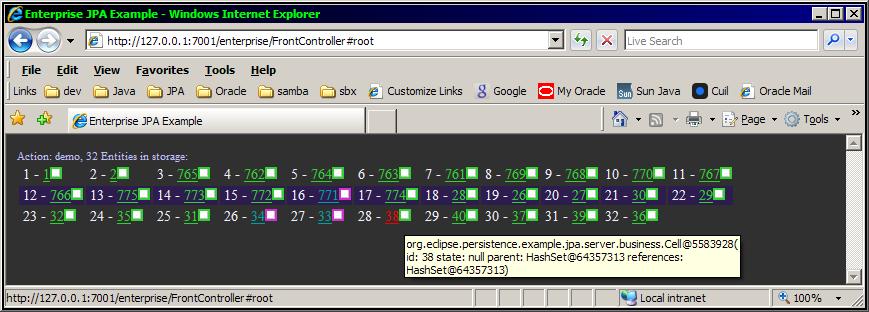
Two Persistence Units
This section details a use case where we need to use two different persistence units defined in the same persistence.xml file where the datasources are on different physical database servers.
The following capture is from a persistence.xml mapping file on the EJB.jar that has two persistence units where each point to the same Entity name "Cell" but the entities are in different packages. This will test any possible naming conflict between the entities.
persistence.xml with three persistence units
<persistence version="1.0" xmlns="http://java.sun.com/xml/ns/persistence" xmlns:xsi="http://www.w3.org/2001/XMLSchema-instance" xsi:schemaLocation="http://java.sun.com/xml/ns/persistence http://java.sun.com/xml/ns/persistence/persistence_1_0.xsd"> <persistence-unit name="exampleDuplicate" transaction-type="JTA"> <provider>org.eclipse.persistence.jpa.PersistenceProvider</provider> <jta-data-source>remoteJTA</jta-data-source> <class>org.eclipse.persistence.example.jpa.server.entity.Cell</class> <exclude-unlisted-classes>true</exclude-unlisted-classes> <properties> <property name="eclipselink.target-server" value="WebLogic_10"/> <property name="eclipselink.logging.level" value="FINEST"/> <!-- property name="eclipselink.orm.validate.schema" value="false"/--> </properties> </persistence-unit> <persistence-unit name="example" transaction-type="JTA"> <provider>org.eclipse.persistence.jpa.PersistenceProvider</provider> <jta-data-source>localJTA</jta-data-source> <class>org.eclipse.persistence.example.jpa.server.business.Cell</class> <exclude-unlisted-classes>true</exclude-unlisted-classes> <properties> <property name="eclipselink.target-server" value="WebLogic_10"/> <property name="eclipselink.logging.level" value="FINEST"/> <!-- property name="eclipselink.orm.validate.schema" value="false"/--> </properties> </persistence-unit> <persistence-unit name="exampleLocal" transaction-type="RESOURCE_LOCAL"> <provider>org.eclipse.persistence.jpa.PersistenceProvider</provider> <class>org.eclipse.persistence.example.jpa.server.business.Cell</class> <exclude-unlisted-classes>true</exclude-unlisted-classes> <properties> <property name="eclipselink.jdbc.driver" value="oracle.jdbc.driver.OracleDriver"/> <property name="eclipselink.jdbc.platform" value="org.eclipse.persistence.platform.database.oracle.OraclePlatform"/> <property name="eclipselink.jdbc.url" value="jdbc:oracle:thin:@127.0.0.1:1521:orcl"/> <property name="eclipselink.jdbc.user" value="scott"/> <property name="eclipselink.jdbc.password" value="pw"/> <!-- property name="eclipselink.logging.logger" value="JavaLogger"/--> <!-- turn on table generation only to initialize db and then disable the two elements below --> <!-- property name="eclipselink.ddl-generation" value="drop-and-create-tables"/> <property name="eclipselink.ddl-generation.output-mode" value="database"/--> </properties> </persistence-unit> </persistence>
In the case of using both persistence units I get 2 sets of 4 logs = 8 for the 4 connections to the 2 datasources The two datasources in my case are Oracle11g (remoteJTA) and Oracle10g (localJTA) - both using the same 11g driver - so it is easier to tell them apart in the logs.
EL Example: enterprise: Object: org.eclipse.persistence.example.jpa.server.entity.Cell@26145598( id: 1 state: null left: null right: null parent: HashSet@234560 references: HashSet@234560)
When i use the exampleDuplicate persistence unit i get a login for the first Oracle 10g based datasource (remoteJTA)
EL Config: 2008.12.15 15:43:56.419--ServerSession(3303389)--Connection(28810575)--Thread(Thread[)--Connected: jdbc:oracle:thin:@127.0.0.1:1521:orcl User: SCOTT Database: Oracle Version: Oracle Database 11g Enterprise Edition Release 11.1.0.6.0 - Production With the Partitioning, OLAP, Data Mining and Real Application Testing options Driver: Oracle JDBC driver Version: 11.1.0.7.0-Production EL Config: 2008.12.15 15:43:56.419--ServerSession(3303389)--Connection(28892307)--Thread(Thread[)--connecting(DatabaseLogin( platform=>Oracle10Platform user name=> "" connector=>JNDIConnector datasource name=>null ))
and the persist call for the first set of entities in the first persistence unit
EL Example: enterprise: ApplicationService persisting: org.eclipse.persistence.example.jpa.server.business.Cell@13251215( id: null state: null left: null right: null parent: HashSet@18981093 references: HashSet@18981093) on EM: org.eclipse.persistence.internal.jpa.EntityManagerImpl@1a7ed8f> later when I use the other example persistence unit i get a login for the second datasource
Later when using the Oracle 11g based datasource (localJTA)
EL Config: 2008.12.15 15:43:56.966--ServerSession(25279766)--Connection(6794127)--Thread(Thread[)--Connected: jdbc:oracle:thin:@10.156.53.19:1521:orcl User: SCOTT Database: Oracle Version: Oracle Database 10g Enterprise Edition Release 10.2.0.1.0 - Production With the Partitioning, OLAP and Data Mining options Driver: Oracle JDBC driver Version: 11.1.0.7.0-Production EL Config: 2008.12.15 15:43:56.966--ServerSession(25279766)--Connection(3176465)--Thread(Thread[)--connecting(DatabaseLogin( platform=>Oracle10Platform user name=> "" connector=>JNDIConnector datasource name=>null ))
And the persist call for the second set of entities in the second persistence unit
EL Example: enterprise: ApplicationService2 persisting: org.eclipse.persistence.example.jpa.server.entity.Cell@20979305( id: null state: null left: null right: null parent: HashSet@14247956 references: HashSet@14247956) on EM: org.eclipse.persistence.internal.jpa.EntityManagerImpl@14bf56d
The servlet client uses two stateless session beans for entitymanager access
public class FrontController extends HttpServlet implements Servlet { @EJB(beanName="ApplicationService") public ApplicationServiceLocal applicationService; @EJB(beanName="ApplicationService2") public ApplicationServiceLocal2 applicationService2; ... // Later I must fully reference my entities because in this case they have the same class name in different packages List<org.eclipse.persistence.example.jpa.server.business.Cell> rowsList = (List<org.eclipse.persistence.example.jpa.server.business.Cell>)getApplicationService().query("select object(e) from Cell e"); List<org.eclipse.persistence.example.jpa.server.entity.Cell> rowsList2 = (List<org.eclipse.persistence.example.jpa.server.entity.Cell>)getApplicationService2().query("select object(e) from Cell e");
Each entitymanager is injected into the stateless session beans
package org.eclipse.persistence.example.jpa.server.entity; @Local @Stateless public class ApplicationService implements ApplicationServiceLocal { @PersistenceContext(unitName="example", type=PersistenceContextType.TRANSACTION) private EntityManager entityManager;
package org.eclipse.persistence.example.jpa.server.entity; @Local @Stateless public class ApplicationService2 implements ApplicationServiceLocal2 { @PersistenceContext(unitName="exampleDuplicate", type=PersistenceContextType.TRANSACTION) private EntityManager entityManager;
Both versions of the Cell entity (in different packages but with the same schema on different databases) are located on the ejb.jar along with the session beans
package org.eclipse.persistence.example.jpa.server.entity; @Entity @Table(name="EL_CELL") public class Cell implements Serializable {
package org.eclipse.persistence.example.jpa.server.business; @Entity @Table(name="EL_CELL") public class Cell implements Serializable {
Deploying a Secure Enterprise Application on WebLogic
- In this section we will be describe the steps for getting a secure web application running in a EAR using @PersistenceContext injection on a standard @Stateless @Local session bean that is @EJB injected on a servlet.
WebLogic Server Preparation
- Increase JTA transaction timeout - to aide debugging
- Create JTA datasource
- http://127.0.0.1:7001/console/console.portal?_nfpb=true&_pageLabel=GlobalJDBCDataSourceTablePage
- The database is standalone Derby 10.5.3.0 using a global JTA TX datasource (Type IV XA) set on WebLogic.
- org.apache.derby.jdbc.ClientXADataSource
- jdbc:derby://127.0.0.1:1527/weblogic;create=true;ServerName=127.0.0.1;databaseName=weblogic
- APP:APP
- Create server in Eclipse Helios 3.6 EE
Enabling Security
- 0) The security policy is already set for us - just keep a backup of the original
- -Djava.security.policy=%WL_HOME%\server\lib\weblogic.policy
- 1) Turn on the Security Manager in WebLogic
- $WebLogic_home\user_projects\domains\base_domain\bin\startWebLogic.cmd
- set JAVA_OPTIONS=%JAVA_OPTIONS% -Djava.security.manager
- $WebLogic_home\user_projects\domains\base_domain\bin\startWebLogic.cmd
- 2) Enable the EclipseLink property eclipselink.security.usedoprivileged
- $WebLogic_home\user_projects\domains\base_domain\bin\startWebLogic.cmd
- set JAVA_OPTIONS=%JAVA_OPTIONS% -Declipselink.security.usedoprivileged=true
- There seems to be some confusion about whether to use = or === - I have used a single =.
- $WebLogic_home\user_projects\domains\base_domain\bin\startWebLogic.cmd
- 3) Grant permissions to the localJTA datasource JDBC jar files.
// localJTA
grant codeBase "file:C:/opt/wls10340rc11/wlserver_10.3/common/derby/lib/-" {
permission java.net.SocketPermission "127.0.0.1:1527", "connect,resolve";
};
- Without this you will see the following unrelated to EclipseLink permissions exception
- <12-Jan-2011 11:43:01 o'clock AM VET> <Warning> <JDBC> <BEA-001129> <Received exception while creating connection for pool "localJTA": access denied (java.net.SocketPermission 127.0.0.1:1527 connect,resolve)>
- 4) According to http://wiki.eclipse.org/Integrating_EclipseLink_with_an_Application_Server_(ELUG)#Granting_Permissions_for_Java_EE_Application_Deployment we need to grant access to the EclipseLink module as well
- This step may be optional - as I predeploy the persistence unit fine without it
- [EL Finest]: 2011-01-12 12:50:47.014--ServerSession(24567153)--Thread(Thread[[ACTIVE] ExecuteThread: '0' for queue: 'weblogic.kernel.Default (self-tuning)',5,Pooled Threads])--Begin predeploying Persistence Unit example; session file:/C:/view_w36a/examples/org.eclipse.persistence.example.jpa.server.weblogic.enterpriseEJB/build/classes/_example; state Initial; factoryCount 0
- $WebLogic_home/modules/org.eclipse.persistence_1.0.0.0_2-x.jar
grant codeBase "file:C:\opt\wls10340rc11\modules/org.eclipse.persistence_1.0.0.0_2-1.jar" {
permission java.security.AllPermission;
};
- 5) Grant specific access to the WAR and the EJB jar that provides the SSB proxy
grant codeBase "file:C:/opt/wls---/user_projects/domains/base_domain/servers/AdminServer/cache/EJBCompilerCache/-" {
permission java.security.AllPermission;
};
Unmodified WebLogic Server
- The following permissions exception involving the new JTA datasource occurs even before we deploy any ears. This resource java.net.SocketPermission 127.0.0.1:1527 connect,resolve must be granted permissions and is unrelated to EclipseLink deployment.
- modules unchanged
- javax.persistence_1.0.0.0_1-0-2.jar
- javax.persistence_1.0.0.0_2-0-0.jar
- org.eclipse.persistence_1.0.0.0_2-1.jar
- $WebLogic_home\user_projects\domains\base_domain\bin\startWebLogic.cmd
- $WebLogic_home\wlserver_10.3\server\lib\weblogic.policy
- C:\view_w36a\examples\org.eclipse.persistence.example.jpa.server.weblogic.enterpriseEJB\ejbModule\META-INF\weblogic-ejb-jar.xml
- modules unchanged
<12-Jan-2011 11:43:01 o'clock AM VET> <Warning> <JDBC> <BEA-001129> <Received exception while creating connection for pool "localJTA": access denied (java.net.SocketPermission 127.0.0.1:1527 connect,resolve)> <12-Jan-2011 11:43:02 o'clock AM VET> <Error> <Deployer> <BEA-149205> <Failed to initialize the application 'localJTA' due to error weblogic.application.ModuleException: . weblogic.application.ModuleException: at weblogic.jdbc.module.JDBCModule.prepare(JDBCModule.java:302) at weblogic.application.internal.flow.ModuleListenerInvoker.prepare(ModuleListenerInvoker.java:199) at weblogic.application.internal.flow.DeploymentCallbackFlow$1.next(DeploymentCallbackFlow.java:517) at weblogic.application.utils.StateMachineDriver.nextState(StateMachineDriver.java:52) at weblogic.application.internal.flow.DeploymentCallbackFlow.prepare(DeploymentCallbackFlow.java:159) Truncated. see log file for complete stacktrace Caused By: weblogic.common.ResourceException: access denied (java.net.SocketPermission 127.0.0.1:1527 connect,resolve) at weblogic.jdbc.common.internal.XAConnectionEnvFactory.makeConnection(XAConnectionEnvFactory.java:494) at weblogic.jdbc.common.internal.XAConnectionEnvFactory.createResource(XAConnectionEnvFactory.java:177) at weblogic.common.resourcepool.ResourcePoolImpl.makeResources(ResourcePoolImpl.java:1249) at weblogic.common.resourcepool.ResourcePoolImpl.makeResources(ResourcePoolImpl.java:1166) at weblogic.common.resourcepool.ResourcePoolImpl.start(ResourcePoolImpl.java:249)
- Fix is to enable permissions - see http://download.oracle.com/docs/cd/E13222_01/wls/docs81/jdbc_drivers/usedriver.html#1063261
Troubleshooting
- 1) If you get a "domain locked" popup error in eclipse when publishing your ear - delete the following lock file in your server domain
- $WEBLOGIC_HOME\user_projects\domains\base_domain\edit.lok
- 2) If you get a WST error popup in Eclipse when you try to export your EAR - it is most likely due to an inconsistent workspace (a file is missing/modified on the disc but has not been refreshed to the Eclipse IDE) - try refreshing the 3 projects here first.
- 3) If you have changed your entity schema between deployments and you find some weird behavior where you are seeing both your new entities and the old entities (without the schema changes) - this is most likely due to a cached entity on the server that has not been updated for some reason - usually when you combine both manual deployment to the autodeploy directory and "run-on-server" from the Eclipse IDE.
- The workaround is to clear non-session entities from the cache under
- user_projects\domains\base_domain\servers\AdminServer\cache\EJBCompilerCache
Password Encryption Error
For application defined datasources, if you get the following invalid pad byte exception when deploying your EAR to WebLogic 10.3 then check that you are using the latest AES encryption instead of 3DES. You can regenerate your encrypted password by creating a temporary globally defined datasource and viewing the *jdbc.xml file generated on your domain config directory.
Feb 20, 2009 11:46:01 AM EST> <Error> <Deployer> <BEA-149265> <Failure occurred in the execution of deployment request with ID '1235148360979' for task '20'. Error is: 'com.rsa.jsafe.JSAFE_PaddingException: Could not perform unpadding: invalid pad byte.' com.rsa.jsafe.JSAFE_PaddingException: Could not perform unpadding: invalid pad byte. at com.rsa.jsafe.JA_PKCS5Padding.a(Unknown Source) at com.rsa.jsafe.JG_BlockCipher.decryptFinal(Unknown Source) at weblogic.security.internal.encryption.JSafeEncryptionServiceImpl.decryptBytes(JSafeEncryptionServiceImpl.java:113) at weblogic.security.internal.encryption.JSafeEncryptionServiceImpl.decryptString(JSafeEncryptionServiceImpl.java:173) at weblogic.security.internal.encryption.ClearOrEncryptedService.decrypt(ClearOrEncryptedService.java:96)
<password-encrypted>{AES}...=</password-encrypted>
EJB bean JNDI client lookup without injection
See http://forums.oracle.com/forums/thread.jspa?threadID=2159122&tstart=0
The following steps need to be done so that a non-servlet client (J2SE) can lookup an instance of the stateless session bean deployed on WebLogic by this application.
wlfullclient.jar
This wlfullclient.jar is generated with all the libraries an SE application needs that would normally be provided to an EE container app out of the box. In the case of WebLogic this client jar is generated at design time. In the case of GlassFish the equivilant gf-client.jar is provided as a manifest only jar that references the EE libraries by relative path.
Node.java
@Stateful(mappedName="ejb/Node") @Local public class Node implements NodeRemote, NodeLocal {
Host SE client
package org.eclipse.persistence.example.distributed; import java.rmi.ConnectException; import java.util.ArrayList; import java.util.HashMap; import java.util.Hashtable; import java.util.List; import java.util.Map; import javax.ejb.EJBException; import javax.naming.Context; import javax.naming.InitialContext; import javax.rmi.PortableRemoteObject; import org.eclipse.persistence.example.distributed.NodeRemote; /** * This class tests RMI connections to multiple WebLogic servers running on * remote JVM's. It is intended for experimental concurrency investigations only. * Note: for non-EE/ejb/web contexts (SE) use wlfullclient.jar generated from * $WLS_INSTALL\wlserver_10.3\server\lib>java -jar wljarbuilder.jar * 20110106: refactor for generic remote connections * @author mfobrien 20100916 * */ public class Host { /** RMI server key name - does not need to resolve under DNS */ public static String serverDNS[] = {"beowulf5","beowulf6", "x-pc2"}; /** RMI t3 URL */ public static String serverT3[] = {"t3://192.168.0.165:7001","t3://192.168.0.166:7001", "t3://1x.x.x.x:7001"}; private int numberServers = serverDNS.length; /** list of server names from above arrays */ private List<String> serverNames = new ArrayList<String>(); /** Input context map hashtable entries - For JNDI we are forced to use Hashtable instead of HashMap*/ private Map<String, Hashtable<String, String>> contextHashtableMap = new HashMap<String, Hashtable<String, String>>(); /** output cached context maps for each remote server */ private Map<String, Context> rmiCachedContextMap = new HashMap<String, Context>(); /** $Proxy remote objects */ private Map<String, NodeRemote> remoteObjects = new HashMap<String, NodeRemote>(); /** remote propagation value */ private Map<String, Integer> stateToSet = new HashMap<String, Integer>(); /** How many processors are available (real + hyperthreaded) */ private Map<String, Integer> availableProcessors = new HashMap<String, Integer>(); /** whether the node is accepting requests or not */ private Map<String, Boolean> nodeUnavailable = new HashMap<String, Boolean>(); /** map of t3 protocol URLs */ private Map<String, String> serverIPMap = new HashMap<String, String>(); // verify that all EE libraries available via http://download.oracle.com/docs/cd/E12840_01/wls/docs103/client/jarbuilder.html private static final String CONTEXT_FACTORY_NAME = "weblogic.jndi.WLInitialContextFactory"; private static final String SESSION_BEAN_REMOTE_NAME = "ejb/Node#org.eclipse.persistence.example.distributed.NodeRemote"; //private String sessionBeanRemoteName = "java:comp/env/ejb/Node"; // EE only //private String sessionBeanRemoteName = "org_eclipse_persistence_example_distributed_ClientEARorg_eclipse_persistence_example_distributed_ClientEJB_jarNode_Home" ; public Host() { // initialize state for(int i=0;i<numberServers;i++) { // For each server add the name key and corresponding RMI URL serverNames.add(serverDNS[i]); serverIPMap.put(serverDNS[i], serverT3[i]); nodeUnavailable.put(serverDNS[i], false); availableProcessors.put(serverDNS[i], 0); Hashtable<String, String> aTable = new Hashtable<String, String>(); contextHashtableMap.put(serverDNS[i],aTable); aTable.put(Context.INITIAL_CONTEXT_FACTORY,CONTEXT_FACTORY_NAME); aTable.put(Context.PROVIDER_URL, serverT3[i]); } } public void connect() { //System.out.println("Available Processors on this System: " + availableProcessors); /** * Setup and connect to RMI Objects */ try { // Establish RMI connections to the session beans for(String aServer : serverNames) { Context aContext = null; try { aContext = new InitialContext(contextHashtableMap.get(aServer)); rmiCachedContextMap.put(aServer, aContext); System.out.println("Context for " + aServer + " : " + aContext); // For qualified name look for weblogic log "EJB Deployed EJB with JNDI name" Object aRemoteReference = aContext.lookup(SESSION_BEAN_REMOTE_NAME); System.out.println("Remote Object: " + aRemoteReference); // narrow the $proxy remote bean NodeRemote aNode = (NodeRemote) PortableRemoteObject.narrow(aRemoteReference, NodeRemote.class); remoteObjects.put(aServer, aNode); System.out.println("Narrowed Session Bean: " + aNode); // initialize state list stateToSet.put(aServer, new Integer(0)); } catch (Exception ce) { // server down throws a javax.naming.CommunicationException inside a java.net.ConnectException ce.printStackTrace(); // mark the current node as down, clear the flag in 5 min nodeUnavailable.put(aServer, true); } } NodeRemote aNode; StringBuffer aBuffer = new StringBuffer(); // Endlessly generate RMI requests for(;;) { // Send messages to entire grid in parallel for(String remoteServer : remoteObjects.keySet()) { aNode = remoteObjects.get(remoteServer); // increment server's pending state stateToSet.put(remoteServer, stateToSet.get(remoteServer).intValue() + 1); if(!nodeUnavailable.get(remoteServer)) { try { // Issue: One JVM halt will affect the entire distributed app. // don't let a node failure halt the host aNode.setState(stateToSet.get(remoteServer)); // this remote call can throw an EJBException wrapping a java.rmi.ConnectException aBuffer = new StringBuffer("State from: "); aBuffer.append(remoteServer); aBuffer.append(" = "); aBuffer.append(aNode.getState()); System.out.println(aBuffer.toString()); } catch (EJBException e) { // weblogic.transaction.internal.TimedOutException: Transaction timed out after 29 seconds // or // EJBException wrapping a java.rmi.ConnectException if the server is not running e.printStackTrace(); // mark the current node as down, clear the flag in 5 min nodeUnavailable.put(remoteServer, true); } } } } } catch (Exception e) { e.printStackTrace(); } } public Map<String, Hashtable<String, String>> getContextMap() { return contextHashtableMap; } public void setContextMap(Map<String, Hashtable<String, String>> contextMap) { this.contextHashtableMap = contextMap; } public Map<String, Context> getRmiContextMap() { return rmiCachedContextMap; } public void setRmiContextMap(Map<String, Context> rmiContextMap) { this.rmiCachedContextMap = rmiContextMap; } public Map<String, NodeRemote> getRemoteObjects() { return remoteObjects; } public void setRemoteObjects(Map<String, NodeRemote> remoteObjects) { this.remoteObjects = remoteObjects; } public Map<String, Integer> getStateToSet() { return stateToSet; } public void setStateToSet(Map<String, Integer> stateToSet) { this.stateToSet = stateToSet; } public Map<String, Boolean> getNodeUnavailable() { return nodeUnavailable; } public void setNodeUnavailable(Map<String, Boolean> nodeUnavailable) { this.nodeUnavailable = nodeUnavailable; } public Map<String, String> getServerIPMap() { return serverIPMap; } public void setServerIPMap(Map<String, String> aServerIPMap) { serverIPMap = aServerIPMap; } public List<String> getServernames() { return serverNames; } public void setServerNames(List<String> serverNames) { this.serverNames = serverNames; } public int getNumberServers() { return numberServers; } public void setNumberServers(int numberServers) { this.numberServers = numberServers; } public Map<String, Integer> getAvailableProcessors() { return availableProcessors; } public void setAvailableProcessors(Map<String, Integer> availableProcessors) { this.availableProcessors = availableProcessors; } public static void main(String[] args) { Host host = new Host(); host.connect(); } }
JMX MBeans
- See work to enable EclipseLink MBeans on WebLogic, JBoss, WebSphere and Glassfish in enhancement 316513
JMX MBeans on WebLogic via SUN JConsole
- Enable the eclipselink properties on the startup script
- enable Anonymous Admin Lookup Enabled on the domain|security tab in the WebLogic console.
- To view MBeans on WebLogic 10.3 use the following standard SUN JDK 1.6 Jconsole application - use these classpath and connection string settings.
- Set your path to the target JVM - here it should be either the bundled SUN JDK or the JRockit JVM.
- Launch JConsole
C:\>jconsole -J-Djava.class.path=C:/opt/wls1031_l16/jdk160_11/lib/jconsole.jar;C:/opt/wls1031_l16/jdk160_11/l ib/tools.jar;C:/opt/wls1031_l16/wlserver_10.3/server/lib/wljmxclient.jar -J-Djmx.remote.protocol.provider.pkgs=weblogic.management.remote -J-Dcom.sun.management.jmxremote
- Make sure the following propery is set if the platform MBean server is required (the one containing the bea/weblogic packages)
-Djavax.management.builder.initial=weblogic.management.jmx.mbeanserver.WLSMBeanServerBuilder
- You will see the following dialog - select the remote service section.
- Note: however this method of launching JConsole restricts you to the MBean tab, to view the other memory, threads, vm summary, classes tabs launch jconsole normally without parameters by selecting the weblogic.Server local process
service:jmx:rmi:///jndi/iiop://127.0.0.1:7001/weblogic.management.mbeanservers.runtime or service:jmx:t3://127.0.0.1:7001/jndi/weblogic.management.mbeanservers.runtime username/password = weblogic console username/password
- You will see the following TopLink/EclipseLink tree as well as other application specific management branches in the JConsole view
JMX MBeans on WebLogic via JRockit Mission Control (JRMC)
- Launch JRockit MC (C:\opt\wls10330\jrockit_160_17_R28.0.0-679\bin\jrmc.exe)
- Connect to the weblogic server process
- Hit the MBeans Icon and navigate the tree to "TopLink:session"
References
- See Integrating EclipseLink with an Application Server in the ELUG
- See Developing JPA Projects in the EclipseLink User's Guide.
- http://dev.eclipse.org/svnroot/rt/org.eclipse.persistence/trunk/examples/org.eclipse.persistence.example.jpa.server.weblogic.enterpriseEAR
- http://dev.eclipse.org/svnroot/rt/org.eclipse.persistence/trunk/examples/org.eclipse.persistence.example.jpa.server.weblogic.enterpriseEJB
- http://dev.eclipse.org/svnroot/rt/org.eclipse.persistence/trunk/examples/org.eclipse.persistence.example.jpa.server.weblogic.enterpriseWeb
- EclipseLink Architecture
- EclipseLink UML Class diagram
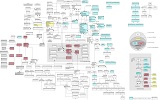
Bugs
- 211206 : Create SVN location and guidelines for the development and maintenance of Examples
- 249213 : JPA 2.0 Resolve container issues with new JPA 2.0 libraries
- 249541 : Examples: Update WebLogic JPA EAR example tutorial in SVN
- 250473 : Examples: Add J2SE application-managed JPA DDL generation project for Java EE EAR tutorials
- 284259 : JPA: Update tutorial wiki for WebLogic 10.3 to match the Oracle WebLogic 11g July release
- 288275 : JPA: Wiki: Update WebLogic JPA example server plugin config for Eclipse 3.5 Galileo
- 294745 : JPA: Add downloadable 60k weblogic.EAR to wiki page (outside of SVN)
- 296271 : JPA 2.0: Add WebLogic 10.3 configuration process to enable the JPA 2.0 library functionality
- 308477 : EE CM behavior of JPA eclipselink.jar placement in EAR - investigate and document
- 309981 : Examples: submit common consolidated <jar-file> entities.jar for all WebLogic, WebSphere, JBoss, OC4J and SE DDL project persistence units
- 310849 : JPA: Update tutorial wiki for WebLogic 10.3 to match the Oracle WebLogic 11g 10.3.3.0
- 316509 : JMX: Move JMX MBean support for WebLogic 10.3 to a generic ServerPlatformBase
Oracle WebLogic Server Documentation Links
- Oracle WebLogic Server Downloads - choose the version that includes Oracle Enterprise Pack for Eclipse Oracle WebLogic Server 11gR1 (10.3.4) + OEPE - Package Installer
- The Eclipse plugin is now available via the "add additional servers" link in the Eclipse IDE for WebLogic Server 11gR1 (10.3.4.0)
- WebLogic Server support for JPA 2.0
- Oracle WebLogic Server 10.3 Documentation
- WebLogic EJB 3.0 Metadata Annotations Reference
- WebLogic Server command line options -including how to patch
- Oracle Spatial API configuration
- Oracle Enterprise Pack for Eclipse JPA code-generation Tutorial - 20100326: The HRApp EAR may have redeploy issues - remove/readd the EAR or restart the server if modifying the source on a live instance.
- WebLogic 10.3.0 EM injection issue and a JNDI override solution by Michael Sikora
- WebLogic ClassLoaders
- Standalone client for Remote Stateless Session EJB beans on WebLogic servers - instructions for eradicating CNFE for WebLogic implementations of javax.ejb, javax.transaction and javax.naming Java EE API
- Section 2.3.3: Task 3: Update the Version of EclipseLink in WebLogic Server at OTN is partially based on this original EclipseLink tutorial.

